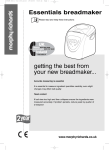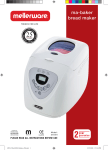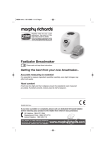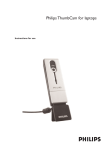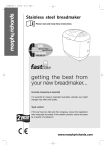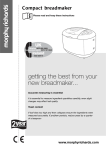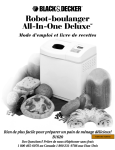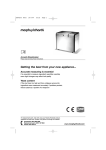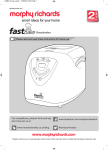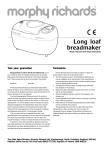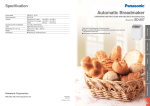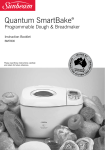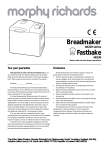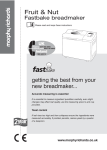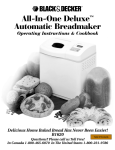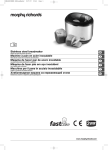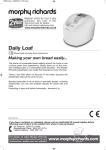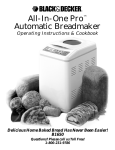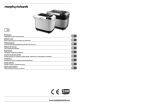Download Mellerware MA-BAKER 26500 Operating instructions
Transcript
MA-BAKER makes life easier bread maker Bread, cake, jam & dough recipes included Non-stick baking pan, bakes up to 900g loaves LCD panel with 12 electronic programmes N er l Re o s e y o ur r e c eip t Includes gluten-free recipes ev g i s t e r o n li n e 2 YEAR GUARANTEE 26500_IM.indd 1 2012/11/26 02:34:16 PM Important safety instructions: The use of any electrical appliance requires taking note of the following safety rules. Primarily there is the danger of personal injury and secondly the danger of damage to property and the appliance. These are indicated in the text by the following two conventions: WARNING:Danger of personal injury. IMPORTANT:Damage to the appliance. In addition we offer the following essential safety advice. Location: •Always place and use your appliance away from the edge of a table. •Ensure that the appliance is used on a firm and flat surface. •Do not use the appliance outdoors. Power Cord: •The power cord should reach from the base of the appliance to the wall socket without straining the connections. •Do not let the power cord hang over the edge of a table where a child could reach it. •Do not let the power cord run across an open space e.g. between a low wall socket and a table. •Do not let the power cord run across a cooker or a toaster or any other heat source which might damage the power cord. Your safety: •WARNING: Do not touch hot surfaces. Use oven gloves when removing the hot bread pan from the appliance. Do not cover the steam vent openings under any circumstances. •WARNING: Avoid contact with moving parts. •To protect against electrical shock, do not immerse the appliance, it’s power cord or it’s plug in water or any other liquid. •Extreme caution must be used when 26500_IM.indd 2 moving an appliance with hot contents. •Do not use the breadmaker for any storage purposes, or insert any utensils in it, as this may create a fire or cause an electric shock. •Do not use the appliance with wet hands. Children: •Do not allow a child to operate this appliance, while unsupervised. •Teach children to be aware of the dangers in the kitchen, warn them of the dangers of reaching up to areas where they cannot see properly or should not be reaching. Other safety considerations: •If the power cord of this appliance is damaged do not use it. The power cord may only be replaced by an approved service centre or repair agent. •The use of attachments not recommended by the manufacturer may cause damage to the breadmaker. •Do not place the appliance on or near any heat sources e.g. electric stove, ovens, or gas burners. •To avoid damaging the appliance, do not place the baking pan or any object on top of the appliance. •Do not clean the appliance or its accessories with anything abrasive. Do not wash the baking pan, kneading blade, measuring cup or spoon in a dishwasher. •Keep the appliance and it’s power cord away from heat, direct sunlight, moisture and sharp edges. •The baking pan must be placed inside the appliance prior to switching it on. •Always remove the plug from the wall socket when the appliance is not in use, when attaching accessories and when cleaning the appliance. 2012/11/26 02:34:16 PM Contents: Operating instructions: Important safety instructions Introduction Before first use Electrical requirements About this breadmaker About the recipes Components Program descriptions Using your breadmaker Using the timer Beeper Power interruption Slicing and storing bread Care and cleaning Storing the unit Know your ingredients Measuring ingredients Ingredient temperatures Creating your own yeast breads Special glazes for yeast breads Other tips 2 3 3 3 3 3 5 6 6 8 8 8 8 9 9 10 11 12 12 13 13 Recipes: Basic breads: Basic white bread Soft grain bread Brown loaf Italian herb bread Cheese & onion bread Raisin bread Sun-dried tomato loaf Malt loaf French bread 14 14 14 14 14 14 14 15 15 Whole wheat breads: Whole wheat bread Granary loaf 15 15 Quick setting: Banana and nut bread Porridge oats bread 15 15 26500_IM.indd 3 Sweet: Mixed fruit loaf Chocolate bread 15 16 Fastbake I: Fastbake small white 16 Fastbake II: Fastbake large white 16 Dough recipes: White bread rolls Whole wheat bread rolls Hot cross buns Pizza base 16 16 16 17 Jams: Marmalade Raspberry and apple 17 17 Cake recipes: Standard cake mix Mixed fruit cake 17 17 Sandwich: Sandwich loaf Soft grain sandwich loaf 18 18 Gluten Free Bread: Rice bread Grain bread Rice and besan bread Fruit loaf 18 19 19 20 20 Further information: Need help? Troubleshooting 20 23 2012/11/26 02:34:16 PM Introduction: The aroma of homemade bread wafting around the home is one of those great smells. Bread, fresh from the oven, with melting butter is a memorable taste sensation. The Mellerware Ma Baker breadmaker can create that experience every morning. There’s very little effort on the part of the baker, because the breadmaker is a sophisticated appliance that does all the work for you. It’s as simple as one-two-three. •Put in the ingredients. •Select the program from the menu and press start. •Wait for your bread. But don’t stop at baking bread in this appliance. Besides being able to do all kinds of speciality breads, including whole wheat, you can also prepare doughs for bread rolls, pizza, cake and there is also a setting for jam. Everything is easy and tastes homemade - because it is. Before first use: Please take a few minutes to read this instruction manual and to find a place to keep it safe for future reference. Pay particular attention to the safety instructions. •Carefully unpack the breadmaker and remove all the packaging materials. •Remove any dust that may have accumulated during packaging. •Wipe the baking pan, kneading blade and the outside surface of the bread maker with a clean, damp cloth. The bread pan has a non-stick coating. Do not use any abrasive materials to clean any part of the breadmaker. •Before first use, use oil, butter or margarine to grease the bread pan and bake empty for about 10 minutes (select the Extrabake program). •Clean once more. •Place the kneading blade on the shaft 26500_IM.indd 4 in the baking pan. During the manufacturing process it is necessary to lightly grease some parts of the appliance. This may result in the unit emitting some vapour when first used, this is normal. Electrical requirements: •Check that the voltage on the rating label of your appliance corresponds with your house electricity supply. WARNING: THIS APPLIANCE MUST BE PLUGED INTO AN EARTHED WALL SOCKET. About this breadmaker: •It has two settings to make a small 680g (1.5lb) or large 907g (2lb) loaf (approx. weight - depends on recipe). •A Fruit and Nut “beep” signals when extra ingredients can be added so they do not get chopped by the kneading blade. •The “small loaf“ setting (1.5lb) can be used to make a 500g loaf for some of the recipes. About the recipes: The recipes in this booklet have been thoroughly tested to ensure the best results. These recipes have been created by home economists specifically for this appliance and may not produce favourable results in other similar machines. •Always add ingredients in the order they are listed in the recipe. •Accurate measuring of ingredients is vital, do not use larger amounts. 2012/11/26 02:34:16 PM Components Air vents Viewing window Cover Lid handle Control panel Air vents Main body Handle Baking pan Kneading blade Rotating shaft 26500_IM.indd 5 2012/11/26 02:34:17 PM Program descriptions: •Basic white (3:00 and 2:53) For white and brown bread. Also for flavoured breads with herbs or raisins. •French (3:50 and 3:40) For the baking of light weight bread such as french bread which has a crispier crust and a light texture. •Whole wheat (3:40 and 3:32) For the baking of bread containing significant amounts of whole wheat. This setting has a longer pre-heat time to allow the grain to soak up the water and expand. It is not advised to use the time delay function as this will produce poor results. • Quick (1:40) For white bread that is required in a shorter time. Bread baked on this setting is usually smaller with a more dense texture. •Sweet (2:55 and 2:50) For baking of sweet breads which gives a crispier crust than on a basic setting. The crispier crust is produced by the sugar ‘burning’. •Fastbake I (0:58) For preparation of a 680g white loaf in a reduced time period. Loaves made on this setting can be shorter and the texture will be moist. •Fastbake II (0:58) For preparation of a 970g white loaf in a reduced time period. Loaves made on this setting can be shorter and the texture will be moist. •Dough (1:30) This setting only makes the dough and will not bake the final product. Remove the dough and shape it to make bread rolls, pizza, etc. Any dough can be prepared on this setting. Do not exceed 1kg of combined ingredients. •Jam (1:20) Use this setting for making jam from fresh fruits and to make marmalade from Seville oranges. Do not increase 26500_IM.indd 6 the quantity or allow the ingredients to boil over the pan into the baking chamber. Should this happen, stop the machine immediately. Remove the pan carefully, allow to cool and then clean thoroughly. •Cake (2:50) This setting will mix ingredients and then bake for a preset time. Ingredients should be mixed in a separate bowl before adding to the breadmaker (see cake recipes). •Sandwich (3:00 and 2:55) This preset will bake a light textured bread with a soft and thick crust. •Extra bake (1:00) This setting is a bake only setting and can be used to increase the baking time on selected settings. This is useful to help ‘set’ jams and marmalade. Once you have started the “Extrabake” process it is advisable that you check the condition of the bread or jam at 10 minute intervals. When selecting the “Extrabake” preset straight after another program and H:HH is displayed, open the lid and allow to cool for 10 minutes. When cool, replace the baking pan and its contents, set the “Extrabake“ program and then press the “Start/Stop“ button. Using your breadmaker: •Removing the pan: Open the lid and remove the baking pan by lifting the handle, turning anticlock-wise and lifting it out. Place it on a stable work surface. It is important that the baking pan is filled with ingredients outside the machine so that any accidental spillage is not ignited by the heating element. •Attach the blade: Attach the kneading blade to the shaft by pushing down on the blade. 2012/11/26 02:34:17 PM •Measure ingredients: Measure the ingredients required and add them all into the pan in the order listed in the recipe. When adding the yeast to the baking pan, make sure that the yeast does not come into contact with the water or any other liquid, as it will start to activate immediately. Use lukewarm water (21-280C). •Replacing the pan: Place the baking pan back into the breadmaker, turning clockwise to lock into place. Close the lid. •Plug in: Insert the plug into the wall socket. The breadmaker will automatically be set to the basic bread menu and normal time. Everytime you press a button you will hear a “beep” to confirm. •Select the program: Choose the desired setting from the list by pressing the “Menu” button. •Select the weight: Press the “loaf size” button to choose between a small or large loaf size. •Select the colour: Choose the desired crust colour by pressing the “colour button”. •Select the time delay: If you wish the bread to be ready at a later time, set the time delay now. •Start: Press the “Start/Stop” button to start the appliance. The remaining time will count down in one minute intervals. •Progress: The breadmaker will automatically proceed through the selected program. If you have selected a baking program that has a second kneading 26500_IM.indd 7 process,the appliance will “beep” to inform you that fruits and/or nuts may now be added. •It is normal for steam to escape through the vents during the baking process. •Finish: Once the selected baking programme has been completed and the bread is baked the display will show 0:00 and the appliance will “beep” to inform you. •Keep warm: The “keep warm” function will circulate hot air around the bread pan for a further 60 minutes. For the best results, remove the baking pan and loaf within this time period or when the initial program has been completed. The appliance will “beep” 10 times to signal the end of the “keep warm“ function. •Remove the food: Press the “Start/Stop” button, remove the plug from the wall socket and then open the lid. WARNING: Use oven gloves when removing the baking pan (taking care as it is very hot). •Removing the bread: Allow the bread to cool in the pan for 15 minutes, then turn the pan upside down and tap the bottom of the bread pan and remove the bread. Place the bread onto a rack to cool. Immediately fill the pan with warm water to prevent the kneading blade from sticking to the shaft. Occasionally the kneading blade will stay in the loaf. Wait until the loaf has cooled down and then remove the kneading blade with a wooden or plastic utensil to avoid damaging the non-stick coating. 2012/11/26 02:34:17 PM •Always unplug the appliance after use. Do not open the lid while the breadmaker is in operation as this will affect the quality of the bread, especially its ability to rise properly. Only open the lid when the recipe instructs you to add additional ingredients or once it has completed baking. •Room temperature note: The breadmaker will work well in a wide range of temperatures, but there could be a difference in the loaf size between a very warm room and a very cold room. We recommend the room temperature should be between 150C and 340C. Using the timer: Use the timer when you want the bread to be ready at a later time, or in the morning. A maximum time delay of 13 hours can be set. Do not use this function with recipes that use perishable ingredients such as eggs, fresh milk, sour cream, or cheese. •Decide when you want the bread to be ready and calculate the difference in time. For example, if you want a loaf at 8am, and it is now 7.30pm, the difference is 12 1/2 hours. •Enter this time by pressing the Time and Time buttons. The arrows will move the time up or down in 10 minute increments. After you have pressed the “Start/Stop” button, the colon (:) will flash. If you have selected the wrong time, press the “Start/Stop” button for 2 seconds. The timer will go back to the preset time, then repeat the above 2 steps again. •The “time delay” function is able to delay the start time for a maximum of 13 hours. After the selected time 26500_IM.indd 8 delay has elapsed the breadmaker will start with the selected bread making process. Beeper: The beeper sounds: •When pressing any button. •During the second kneading cycle on certain programs to indicate that cereals, fruit, nuts or any other ingredients can now be added. •When the selected program finishes. •When “Keep warm” program finishes. Power interruption: After a brief power supply failure: •In the event of a brief power failure, or if the appliance is switched off for a short time span and on condition that the baking process was stopped before it has started to bake, the process may be restarted by pressing the “Start/ Stop” button. This will allow the appliance to continue the baking process. •If it has gone beyond this point, the process must be started from the very beginning. The ingredients will have to be discarded and you will have to start again with fresh ingredients. Slicing and storing bread: •For the best results place the freshly baked bread on a wire rack and allow to cool for 15-30 minutes before slicing. •Using an electric knife or a sharp knife with a serrated blade, slice the bread in even slices. •Store the unused bread in an air tight plastic container and store at room temperature for up to three days. If the weather is hot and humid, store in the refrigerator overnight. •For longer storage (up to one month), place the bread in an air tight plastic container in the freezer. If you store the bread in the refrigerator, leave it out 2012/11/26 02:34:17 PM •and bring it to room temperature before serving. •Since homemade bread has no preservatives it tends to dry out and become stale faster than commercially produced bread. •Left-over stale bread can be cut into cubes and used in your favourite recipes to make croutons, bread pudding or stuffing. •Be sure the appliance has completely cooled and is clean before storing away. Do not use any of these when clean- ing: •Paint thinner •Benzine •Steel wool pads •Polishing powder •Chemical dust cloth Care and cleaning: •Special care must be taken when cleaning the parts of this appliance that has •Caution: To prevent electric shock, a non-stick coating. make sure the appliance is unplugged •To avoid damaging the non-stick coatbefore undertaking any cleaning task. ing, do not use metal utensils such as spatulas, knives or forks in the baking •Wait until the breadmaker has cooled pan. down. •The non-stick coating may change col our after long term use, this is caused •IMPORTANT: Do not immerse either by moisture and steam and will not the body or the lid of this appliance in affect the performance of the appliance water or any liquid as this may cause or the quality of the baked product. damage and/or electric shock. •The hole in the centre of the kneading blade should be cleaned. Then add a •Exterior: Wipe the lid and outer body of drop of cooking oil and replace it on the appliance with a damp cloth. the shaft in the baking pan. This will prevent the blade from sticking. •Interior: Use a damp cloth to wipe the •Keep all the air vents and openings interior of the breadmaker once it has clear of dust. cooled down completely. •Baking pan: Clean the baking pan with warm water, soap is not necessary. Avoid scratching the non-stick surface. Dry it thoroughly before placing it back into the baking chamber. Do not wash the baking pan, measuring cup, spoon or kneading blades in the dishwasher. Do not soak the baking pan for long periods of time, as this could interfere with the movement of the drive shaft. If the kneading blade becomes stuck in the bread pan, pour hot water over it and allow it to soak for 30 minutes. This will enable you to remove the kneading blade more easily. 26500_IM.indd 9 Storing the unit: All the parts of this appliance must be clean and dry before storing. This includes wiping away any moisture from the viewing window. Close the lid and do not store anything on top of the lid. 2012/11/26 02:34:17 PM Know your ingredients: Understanding baking: It is often said that cooking is an art relying on the creativity of the chef while baking bread is more of a science. This means that the process of combining flour, water and yeast results in a reaction that produces bread. You have to remember that when the ingredients combine with each other they produce a specific result. Read the following information carefully to gain a better understanding of the importance each ingredient plays in the bread making process. Important note on flours: •Whole wheat flour/wholemeal flour: Whole wheat flour/wholemeal flour is milled from the entire wheat kernel which contains the bran and germ and makes it heavier and richer in nutrients when compared to white flour. Breads made with this flour are usually smaller and heavier than white loaves. To over come this whole wheat flour/wholemeal flour can be mixed with Bread flour or strong plain flour to produce a high light textured bread. •Self-raising flour: Self-raising flour contains unnecessary leavening ingredients that will interfere with bread and cake making. It is not recommended for use. Flours, while visibly similar, can be very different by virtue of how they are grown, milled, stored, etc. You may find that you will have to experiment with different brands of flour to help you make that perfect loaf. Storage is also very important. All types of flour should be kept in an airtight container. •Bran: Bran (unprocessed) and Wheat Germ are the coarse outer portions of the wheat or rye grains separated from flour by sifting or bolting. They are often added in small quantities to bread for nutritional enrichment, heartiness and flavour. They are also used to enhance the texture of bread. •All purpose flour/plain flour: All purpose flour is a blend of refined hard and soft wheat flours specially suited for making cakes. This type of flour should be used for the recipes in the “cake/quick bread section”. •Oatmeal: Oatmeal comes from rolled or steel-cut oats. They are used primarily to en- hance flavour and texture. •Strong white flour/bread flour: Bread flour is a high gluten/protein flour that has been treated with condition- ers that give dough a greater suitability for kneading. Bread flour typically has a higher gluten concentration than all types of all purpose flour however, depending on different milling practices, this may vary. Strong plain flour or bread flour are recommended for use with this breadmaker. 26500_IM.indd 10 Other ingredients: •Yeasts (active dry yeast) Yeast through a fermentation process produces gas (carbon dioxide) neces- sary to make the bread rise. The yeast must be able to feed on the sugar and flour’s carbohydrates in order to produce this gas. Fast action granular yeast is used in all recipes that call for yeast. There are basically three different types of yeast available, fresh, tradi- tional dry active and fast action. It is recommended that fast action yeast be 2012/11/26 02:34:17 PM used. Fresh or compressed cake yeast is not recommended as they will produce poor results. Store yeast ac- cording to manufacturers instructions. Ensure your yeast is fresh by check- ing its expiration date. Once a packet of yeast is opened it is important that the remaining contents be immediately resealed and refrigerated as soon as possible for future use. Often bread or dough, which fails to rise, is due to stale yeast being used. The following test can be used to determine whether your yeast is stale and inactive: •Place half a cup of lukewarm water into a small bowl or cup. •Stir 1 tsp. of sugar into the water then sprinkle 2 tsp. of yeast over the surface. •Place bowl or cup in a warm area and allow it to sit for 10 minutes undisturbed. •The mixture should foam and produce a strong yeast aroma. If this does not occur, discard mixture and start again with another packet of dried yeast. •Sugar: Sugar is important for the colour and flavour of breads. It is also food for the yeast as it is part of the fermentation process. Artificial sweeteners cannot be used as a substitute for sugar as the yeast will not react properly with it. •Salt: Salt is necessary to balance the flavour of breads and cakes, and also for the colour of the crust that develops during baking. Salt also limits the growth of yeast. The amounts shown in the reci- pes should not be increased. For di- etary reasons it may be reduced, how ever, your baking may suffer. •Liquids/milk: Liquids such as milk or a combination of powdered milk and water, can be used when making bread. Milk will 26500_IM.indd 11 improve the flavour, provide a velvety texture and soften the crust, while water alone will produce a crispier crust. Some recipes call for juice (orange, apple, etc) to be added as a flavour enhancer. Note: For most recipes we suggest the use of dry skimmed milk. •Eggs: Eggs add richness and a velvety texture to bread doughs and cakes. •Sunflower oil: ‘Shortens’ or tenderises the texture of yeast breads. Butter or margarine can be used as a substitute. If butter or margarine is used directley from the refrigerator it should be softened for easier blending during the mixing cycle. •Baking powder: Baking powder is a raising agent used in cakes. This type of raising agent does not require rising time before bak- ing as the chemical reaction works when liquid ingredients are added. •Bicarbonate of soda: Bicarbonate of soda is another raising agent not to be confused or substi- tuted for baking powder. It also does not require rising time before baking as the chemical reaction works during the baking process. Measuring ingredients: The key and most important step when using your breadmaker is measuring your ingredients precisely and accurately. It is extremely important to measure each liquid and dry ingredient properly or it could result in a poor or unacceptable baking result. The ingredients must also be added into the baking pan in the order in which they are given in each recipe. Liquid and dry measurements are done 2012/11/26 02:34:17 PM used. Fresh or compressed cake yeast is not recommended as they will produce poor results. Store yeast ac- cording to manufacturers instructions. Ensure your yeast is fresh by check- ing its expiration date. Once a packet of yeast is opened it is important that the remaining contents be immediately resealed and refrigerated as soon as possible for future use. Often bread or dough, which fails to rise, is due to stale yeast being used. The following test can be used to determine whether your yeast is stale and inactive: •Place half a cup of lukewarm water into a small bowl or cup. •Stir 1 tsp. of sugar into the water then sprinkle 2 tsp. of yeast over the surface. •Place bowl or cup in a warm area and allow it to sit for 10 minutes undisturbed. •The mixture should foam and produce a strong yeast aroma. If this does not occur, discard mixture and start again with another packet of dried yeast. •Sugar: Sugar is important for the colour and flavour of breads. It is also food for the yeast as it is part of the fermentation process. Artificial sweeteners cannot be used as a substitute for sugar as the yeast will not react properly with it. •Salt: Salt is necessary to balance the flavour of breads and cakes, and also for the colour of the crust that develops during baking. Salt also limits the growth of yeast. The amounts shown in the reci- pes should not be increased. For di- etary reasons it may be reduced, how ever, your baking may suffer. •Liquids/milk: Liquids such as milk or a combination of powdered milk and water, can be used when making bread. Milk will 26500_IM.indd 12 improve the flavour, provide a velvety texture and soften the crust, while water alone will produce a crispier crust. Some recipes call for juice (orange, apple, etc) to be added as a flavour enhancer. Note: For most recipes we suggest the use of dry skimmed milk. •Eggs: Eggs add richness and a velvety texture to bread doughs and cakes. •Sunflower oil: ‘Shortens’ or tenderises the texture of yeast breads. Butter or margarine can be used as a substitute. If butter or margarine is used directley from the refrigerator it should be softened for easier blending during the mixing cycle. •Baking powder: Baking powder is a raising agent used in cakes. This type of raising agent does not require rising time before bak- ing as the chemical reaction works when liquid ingredients are added. •Bicarbonate of soda: Bicarbonate of soda is another raising agent not to be confused or substi- tuted for baking powder. It also does not require rising time before baking as the chemical reaction works during the baking process. Measuring ingredients: The key and most important step when using your breadmaker is measuring your ingredients precisely and accurately. It is extremely important to measure each liquid and dry ingredient properly or it could result in a poor or unacceptable baking result. The ingredients must also be added into the baking pan in the order in which they are given in each recipe. Liquid and dry measurements are done 2012/11/26 02:34:17 PM somewhat differently and are as follows: •Liquid measurements: The measuring cup must be placed on a horizontal flat surface and viewed at eye level (not at an angle) when read- ing amounts. The liquid level line must be aligned to the measurement mark. A ‘guesstimate’ is not good enough as it could throw out the critical balance of the recipe. •Dry measurements: Dry measurements (especially flours) must be done using the measuring cup provided. The measuring cup is based on the American standard 8 fluid oz cup, British cup is 10 fluid oz. Dry measuring must be done by gently spooning ingredients into the measuring cup and then once filled, levelling off with a knife. Scooping or tapping the measuring cup will pack the ingredients and you will end up with more than is required. This extra amount could affect the balance of the recipe. Do not sift the flour, unless stated. When measuring small amounts of dry or liquid ingredients (ie. yeast, sugar, salt, powdered milk, honey, molasses) the measuring spoon which is provided must be used. Measurements must be level, not heaped as this small differ- ence could throw out the critical balance of the recipe. Ingredient temperatures: All ingredients, including this appliance, its baking pan, and especially liquids (water or milk), should be warmed to room temperature 21°C (70°F). If ingredients are too cold, below 10°C (50°F), they will not activate the yeast. Extremely hot liquids, above 40°C (104°F), may kill the yeast. Creating your own yeast breads: With this appliance, even the most inexperienced baker can achieve the satisfying experience of baking a loaf of bread. All of the mystery and hard work is gone. The electronic brain inside this sophisticated appliance will ensure that dough is mixed, kneaded, proofed and baked without you being present. The breadmaker can also prepare dough, and when it is ready, all you have to do is shape it, allow it to rise and then bake in a conventional oven. The recipes on the following pages are ‘tailored’ for this breadmaker. Each recipe features ingredients that best compliment a particular type of bread, and each recipe has been tested in this appliance. It is extremely important to not exceed the amounts of ingredients specified in each of the recipes because it can result in unsatisfactory baking performance. When creating your own yeast bread recipes or baking an old favourite, use the recipes in this instruction manual for converting portions from your recipe so that it will suit your breadmaker. This appliance produces delicious baked goods with ease. The appliance only requires that you carefully follow the recipe’s instructions. In basic cook- ing, normally ‘a pinch of this and a dash of that’ is fine, but not for this appliance. Using an automatic breadmaker requires that you accurately measure each ingredient for the best results. 26500_IM.indd 13 2012/11/26 02:34:17 PM Special glazes for yeast breads: Give your just baked bread a professional finish. Select one of the following special glazes to enhance your bread. •Egg glaze: Beat 1 large egg and 1 tablespoon of water together, brush generously. Note: apply to the dough before bak- ing. •Melted butter crust: Brush melted butter over just baked bread for a softer crust. •Milk glaze: For a softer, shiny crust, brush just baked bread with milk or cream. •Sweet icing glaze: Mix 1 cup of sifted icing sugar with 1 to 2 tablespoons of milk to make a glaze consistency and then drizzle over raisin bread or sweet breads. •Poppy/Sesame/Caraway seed/Oatmeal: Sprinkle your choice of these seeds generously over just glazed bread. Other tips: •Place all the recipe ingredients into the baking pan so that the yeast is not touching any liquid. After completing the process of making dough in your breadmaker. let the dough rise outside the breadmaker, allow 30 minutes or until dough doubles in size. Dough should be lightly greased and covered with grease proof paper and a dry towel. It should be placed in a warm area free from drafts. •Humidity can cause problems, therefore humidity and high altitudes require adjustments. For high humidity areas, add an extra tablespoon of 26500_IM.indd 14 flour if consistency is not right. For high altitude areas, decrease yeast amount by approximately 1/4 teaspoon, and decrease sugar and/or water or milk slightly. •The “DOUGH” setting is great for mixing, kneading and proofing (allowing dough to rise) richer dough like croissant doughs. Use the automatic breadmaker to prepare this dough so that all you need to do is shape and bake it according to your recipe. •When recipes call for a ‘lightly floured surface’, use about 1 to 2 tablespoons of flour on the surface. You may want to lightly flour your fingers or rolling pin for easy dough manipulation. When allowing dough to ‘rest’ and ‘rise’ according to a recipe, place it in a warm, draft-free area. If the dough does not double in size, it may not produce a satisfactory product. •If the dough you are rolling shrinks, cover it and let it rest for a few minutes before rolling again. •Dough may be placed in a plastic container and stored in a freezer for later use. Bring the dough to room temperature before using. •After 5 minutes of kneading, open the lid and check the dough consistency. The dough should form a soft, smooth ball. If too dry, add liquid. If too wet, add flour (1/2 to 1 tablespoon at a time). 2012/11/26 02:34:17 PM Recipes All of the following recipes use this same general method: 1 Measure ingredients into baking pan. 2 Use tepid water 21-28ºC. 3 Insert baking pan securely into unit, close lid. 4 Select appropriate bread setting. 5 Push start button. 6 When bread is done, remove pan from unit using oven mitts. 7 Remove bread from baking pan, (and kneading blade from bread if necessary). 8 Allow to cool before slicing. 1 Recipes for basic breads Basic white bread 450g 3/ cup Water 4 Skimmed milk powder 2 tbsp Sunflower oil 2 tbsp Sugar 1 1/4tbsp Sa lt 1 tsp Strong white bread flour 2 cups Fast action yeast 1 tsp Use setting 1 Basic *Use 680g loaf size setting for 450g loaf Softgrain bread W a ter Skimmed milk powder Su n f lo w e r o i l Su g a r Salt Strong white softgrain bread flour Fast action yeast U se se t t i n g Brown loaf 680g 11/8 21/2 21/2 21/4 cup 1 1/2 cups tbsp 4 tbsp tbsp 4 tbsp tbsp 3 tbsp 1 1 /4 tsp 2 tsp 3 cups 4 cups 11/4 tsp 1 1/4 tsp 1 Basic 1 Basic 680g 900g 1 1/8 21/2 21/2 21/4 1 1/2 cups 4 tbsp 4 tbsp 3 tbsp 2 tsp 4 cups 1 1/4 tsp 1 B a si c 1/ 4 cup tbsp tbsp tbsp tsp 3 cups 11/4tsp 1B a s i c 450g 3/ cup Water 4 Skimmed milk powder 1 1/2 tbsp Sunflower oil 1 1/ 2 tbsp Su g a r 2 1/2 tbsp Sa lt 1 tsp Strong brown bread flour 2 cups Fast action yeast 1 tsp Use setting 1 Basic *Use 680g loaf size setting for 450g loaf 900g 680g 900g 1 cup 2 tbsp 2 tbsp 21/2 tbsp 11/4 tsp 3 cups 11/4 tsp 1Basic 1 1/2 cups 3 tbsp 3 tbsp 4 tbsp 2 tsp 4 cups 1 1/2 tsp 1 Basic Italian herb bread 680g 900g W a ter Skimmed milk powder Su n f lo w e r o i l Su g a r Sa lt Strong white bread flour Dried marjoram D r i e d ba si l D r i e d t h ym e Fast action yeast U se se t t i n g 1 1/8 cup 2 1/2 tbsp 2 1/2 tbsp 2 1/4 tbsp 1 1/2 tsp 3 cups 1 1/2 tsp 1 1/2 tsp 1 1/2 tsp 1 1/4 tsp 1 B a si c 1 1/2 cup 3 tbsp 3 tbsp 2 1/2 tbsp 2 tsp 4 cups 2 tsp 2 tsp 2 tsp 1 1/2 tsp 1 B asi c Cheese & onion bread 680g 900g W a ter Skimmed milk powder Su g a r Salt Onion granules Mature grated cheddar cheese Strong white bread flour Fast action yeast U se se t t i n g 1 cu p 2 tbsp 1 t bsp 1/ tsp 2 1 1/2 tbsp 1 cup 3 cups 1 1/2 tsp 1 B a si c 1 1/4 cup 2 1 /2 tbsp 2 t bsp 1 tsp 2 tbsp 1 1/2 cups 4 cups 1 3/4 tsp 1 B a si c Raisin bread 680g 900g W a ter 1 1/4 cup Skimmed milk powder 3 tbsp Su n f lo w e r o i l 3 t bsp Su g a r 2 t bsp Sa lt 1 1/2 tsp 3/ tsp Cinnamon 4 Strong white bread flour 3 cups Fast action yeast 1 1/2 tsp 5/ cup Raisins* 8 U se se t t i n g 1 B a si c * Add the fruit when the beeper sounds. 1 1/2 cup 4 tbsp 4 tbsp 3 t bsp 2 tsp 1 tsp 4 cups 2 tsp 3/ cup 4 1 B a si c Sun-dried tomato loaf 680g 900g W a ter Skimmed milk powder Su n f lo w e r o i l Sa lt Dried mixed herbs Strong white bread flour Fast action yeast Sun-dried tomatoes U se se t t i n g 1 cu p 2 1/2 tbsp 2 1/4 tbsp 1 1/4 tsp 1 1/2 tsp 3 cups 1 1/4 tsp 3/ cup 8 1 B a si c 1 1/3 cups 3 tbsp 3 tbsp 1 1/2 tsp 2 tsp 4 cups 1 1/2 tsp 1/ cup 2 1 B a si c 14 26500_IM.indd 15 2012/11/26 02:34:18 PM Malt loaf 680g W a ter 1 cu p Sa lt 1 t sp Su n f lo w e r o i l 2 t sp B la ck t r e a cle 11/2 tbsp M a lt e xt r a ct 2 t bsp Pl a i n f l o u r 3 cu ps Fast action yeast 1 tsp 1 / cup Sultanas* 2 U se se t t i n g 1 B a si c * Add the fruit when the beeper sounds 900g 1 1/4 cup 1 t sp 3 t bsp 2 1/2 tbsp 3 t bsp 4 cu p 1 1/4 tsp 3 / cup 4 1 B a si c 2 Recipes for french bread French bread 450g 680g 3 / cup Water 1 cup 4 Skimmed milk powder 11/2 tbsp 2 tbsp 3 / tbsp Sugar 1 tbsp 4 Sa lt 1 tsp 1 t sp Sunflower oil 1 tbsp 1 tbsp Strong white bread flour 2 cups 3 cups Fast action yeast 1 tsp 1 tsp Use setting 2 French 2 French *Use 680g loaf size setting for 450g loaf 900g 1 1/4 cup 2 1/2 tbsp 1 1/4 tbsp 1 1/4 tsp 1 1/2 tbsp 4 cups 1 1/4 tsp 2 French 3 Recipes for wholewheat breads Wholewheat bread 450g 680g 3/ cup Water 1 1/8 cup 4 Skimmed milk powder 1 tbsp 1 1/2 tbsp Sunflower oil 11/2 tbsp 2 tbsp Brown sugar 2 tbsp 2 1/2 tbsp Sa lt 1 t sp 1 1/4 tsp Strong wholemeal bread flour 2 cups 3 cups Fast action yeast 1 tsp 11/4 tsp Vitamin C tablet (crushed) 1x100mg Use setting 3 Wholewheat *Use 680g loaf size setting for 450g loaf Granary loaf W a ter Skimmed milk powder Su n f lo w e r o i l Soft brown sugar Sa lt Granary malted brown bread flour Fast action yeast Vitamin C tablet U se se t t i n g 900g 1 5/8 cup 3 tbsp 3 tbsp 3 1/2 tbsp 1 1/2 tsp 4 cups 1 1/2 tsp 1x100mg 4 Recipes for quick setting Banana and nut bread 900g Ingredients group 1 B u t t e r (m e lt e d) M ilk M a sh e d ba n a n a Egg Walnuts (chopped) Le m o n r i n d 2 t bsp 1 t bsp 1 cu p 1 1 / cup 2 1 t sp Ingredients group 2 Pl a i n f l o u r Bicarboante of soda Baking powder Sugar Salt U se se t t i n g 1 1/2 cup 1 / tsp 2 1 / tsp 4 1 / cup 2 1 / tsp 4 4 Q u i ck Method 1 Mix group 1 together in a separate bowl. 2 Mix group 2 together in a second bowl. 3 Pour mixture into breadpan. M ilk E g g s (be a t e n ) Sunflower oil G o ld e n syr u p Sugar Sa lt Pl a i n f l o u r Po r r i d g e o a t s Baking powder Bicarbonate of soda U se se t t i n g 900g 1 1/8 cup 1 5/8 cup 2 tbsp 3 tbsp 2 t bsp 3 t bsp 2 1/2 tbsp 5 tbsp 1 1/4 tsp 2 tsp 3 cups 4 cups 1 1/4 tsp 1 tsp 1 x 100mg 3 W h o le w h e a t 1 cu p 2 1 / tsp 2 2 t bsp 1 / cup 4 1 t sp 2 cu ps 1 cu p 1 / tsp 2 1 / tsp 2 4 Q u i ck 5 Sweet Mixed fruit loaf 680g 900g Porridge oats bread 450g 3/ cup Water 4 Skimmed milk powder 2 tbsp Sunflower oil 2 tbsp Su g a r 5 tbsp Sa lt 1 tsp Strong white bread flour 2 cups 1/ tsp Nutmeg 2 Fast action yeast 1 tsp 1 /4 cup Dried mixed fruit † Use setting 5 Sweet * Use 680g loaf size setting for 450g loaf † Add the fruit when the beeper sounds 680g 1 1/8 cups 21/2 tbsp 21/2 tbsp 1 / cup 4 11/4 tsp 3 cups 3 / tsp 4 1 1/4 tsp 1 / cup 2 5 Sweet 900g 11/3 cups 3 tbsp 3 tbsp 1/ cup 3 11/2 tsp 4 cups 1 tsp 11/2tsp 2/ cup 3 5 Sweet 15 26500_IM.indd 16 2012/11/26 02:34:19 PM Chocolate bread 680g W a ter 1 cu ps E g g (be a t e n ) 1 m e diu m Skimmed milk powder 1 tbsp Su n f lo w e r o i l 1 t bsp 1 / cup Sugar 2 1 / tsp Salt 2 1 / cups Walnuts (chopped) * 4 Strong white bread flour 2 1/8 cups 1 /2 cup Cocoa powder Fast action yeast 1 tsp U se se t t i n g 5 Sw e e t * Add the walnuts when the beeper sounds 900g 1 1/2 cups 1 m e diu m 1 1/2 tbsp 1 1/2 tbsp 3 / cup 4 1 tsp 3 cups 3 / cup 4 1 1/2 tsp 5 Sw e e t 6 Recipes for Fastbake I Fastbake small white W a ter St r o n g w h i t e br e a d f lo u r Sk i m m e d m i lk po w d e r Sa lt Su g a r Su n f lo w e r o i l Fa st a ct i o n ye a st U se se t t i n g 900g 270m l 3 cu ps 2 t bsp 1 t sp 4 t sp 4 t bsp 3 t sp 6 Fa st ba k e 7 Recipes for Fastbake II Fastbake large white W a ter St r o n g w h i t e br e a d f lo u r Sk i m m e d m i lk po w d e r Sa lt Su g a r Su n f lo w e r o i l Fa st a ct i o n ye a st U se se t t i n g 900g 360m l 4 cu ps 3 t bsp 1 1/2 tsp 5 t sp 5 t bsp 31/2 tsp 7 Fa st ba k e 8 Recipes for dough White bread rolls W a ter Sk i m m e d m i lk po w d e r B u t t e r m e lt e d Su g a r Sa lt St r o n g w h i t e br e a d f lo u r Fa st a ct i o n ye a st U se se t t i n g 1 1/4 cups 1 t bsp 2 t bsp 2 t bsp 1 1/2 tsp 3 1/4 cups 11/2 tsp 8 Dough Method 1 Knead and shape the dough into 6 rolls 2 Place on a greased baking tray 3 Brush lightly with melted butter 4 Cover for 20-25 minutes 5 Allow to rise until they are double in size and glaze 6 Bake for approx 15-20 minutes at 190°C Wholewheat bread rolls W a ter Sk i m m e d m i lk po w d e r B u t t e r (m e lt e d) H oney B r o w n su g a r Sa lt Strong wholewheat bread flour Fa st a ct i o n ye a st U se se t t i n g 1 1/4 cups 2 t bsp 2 t bsp 2 t bsp 1 t bsp 1 1/2 tsp 3 1/4 cups 11/2 tsp 8 Dough Method Follow method given for white rolls. Hot cross buns W a ter Butter (melted) Sugar E g g (be a t e n ) Sa lt St r o n g w h i t e br e a d f lo u r Ci n n a m o n Nutmeg R a i si n s U se se t t i n g 1 cu p 1 / cup 4 1 / cup 4 1 1 t sp 3 3/4 cups 1 t sp 1 / tsp 4 1 cu p 8 Dough Method 1 Divide into 8-12 pieces. Shape and flatten slightly. 2 Glaze with egg and milk (but not the cross). 3 Cover and allow to rise for 30 minutes. 4 Bake in oven 375ºF (190ºC) for 16-18 minutes. 16 26500_IM.indd 17 2012/11/26 02:34:19 PM Pizza base W a ter B u t t e r (m e lt e d) Su g a r Sa lt St r o n g w h i t e br e a d f lo u r Fa st a ct i o n ye a st U se se t t i n g 1 cu p 1 t bsp 2 t bsp 1 t sp 2 3/4 cups 1 t sp 8 Dough Method 1 Pre-heat oven. 2 Shape into a flat round shape. Place on a greased baking tray. Brush lightly with oil. 3 Cover for 15 minutes and allow to rise. 4 Add your desired topping. 5 Bake at approx 200ºC until golden brown. 9 Recipes for jams Marmalade Ju i ce f r o m o r a n g e s R in d o f o r a n ge s gr a t e d Pr e se r vi n g su g a r W a ter Pe ct i n i f n e e d e d U se se t t i n g 3 2 1 1 2 9 m e diu m cu p t bsp t sp Ja m Comments • Warm the jars before filling. • Use extra bake time if needed according to set of the marmalade and the size of the oranges. • Remove the paddle with tongs before pouring the marmalade into the jars. • Do not lift the lid during mixing. • Seville oranges should be used for marmalade but are only availablel in January. If using other oranges pectin will be needed to firm up the marmalade. • This recipe will fill approximately 1 medium (400g) jar. Raspberry and apple jam Raspberries, frozen, measured before defrosting Chopped baking apples (peeled and cored) Pr e se r vi n g su g a r Le m o n ju i ce U se se t t i n g 10 Recipes for cakes Standard cake mix Ingredients group 1 Butter (melted) Vanilla essence E g g s (be a t e n ) Le m o n ju i ce cup tsp 3 m e diu m 2 t sp Ingredients group 2 Pl a i n f l o u r B a k in g po w de r Ca st e r su g a r 1 5/8 cup 2 t sp 1 cu p U se se t t i n g 1 0 Ca k e 3/ 4 1/ 4 Method 1 Mix group 1 together in a separate bowl. 2 Sieve group 2 together in a second bowl. 3 Combine groups 1 and 2 together until mixed. 4 Pour mixture into breadpan. Mixed fruit cake Ingredient group 1 Butter (melted) Vanilla essence Eggs Le m o n ju i ce Dried mixed fruit 3 2 t sp 5 / cup 8 Ingredient group 2 Pl a i n f l o u r B a k in g po w de r Su g a r Ground cinnamon Ground nutmeg 1 5/8 cups 2 t sp 1 cu p 1 / tsp 4 1 / tsp 4 U se se t t i n g 1 0 Ca k e 3/ 4 1/ 4 cup tsp Method Follow method given for standard cake mix. 2 cups 1 cup 1 cu p 3 t bsp 9 Ja m Comments • Warm the jars before filling. • Use tongs to remove the paddle before pouring the jam into prepared jars. • Do not open lid during mixing. 17 26500_IM.indd 18 2012/11/26 02:34:20 PM 11 Recipes for sandwich breads Sandwich loaf 680g 900g 260m l 11/2 tbsp 1 1/3 cups 2 tbsp 1 tsp 2 tbsp 31/2 tbsp 4 cups 1 tsp W a ter Soft margerine or butter Salt Skimmed milk powder Su g a r Strong white bread flour Fast action yeast U se se t t i n g tbsp 3 t bsp 3 cups 3 / tsp 4 1 1 Sa n d w i ch Softgrain sandwich loaf 680g W a ter Butter (melted) Salt Skimmed milk powder Su g a r Strong white softgrain bread flour Fast action yeast U se se t t i n g 26 0 m l 11/2 tbsp tsp 1/ 2 11/2 tsp 1/ 2 11/2 tbsp 3 t bsp 3 cups 3 / tsp 4 1 1 Sa n d w i ch 900g 1 1/3 cups 2 tbsp 1 tsp 2 tbsp 31/2 tbsp 4 cups 1 tsp Gluten Free Breads: We understand the importance of a staple food such as bread in a gluten intolerant individuals diet. Realising that there are breadmakers on the market that do not deliver a suitable Gluten Free loaf, our objective, with the advanced technology of the Ma-Baker, was to develop recipe’s that produced a real result. So all you have to do is simply add the ingredients, press a button and leave the rest up to the Ma-baker. Baking a successful Gluten Free loaf takes practice and a better understanding of the different ingredients. In order to help you along the path to a perfect Gluten Free loaf we have included some handy hints and ingredient information that you should read before attempting to bake your Gluten Free loaf. Handy Hints: • For optimum results carefully follow the instructions for each recipe. • All the Gluten Free breads can be frozen and will keep well. • To ensure that all the ingredients have combined sufficiently, you may need to assist the kneading process. When baking your first few loaves you should inspect the dough texture ap- proximately 5 minutes into the knead- ing process. If there is any unmixed dry ingredients use a plastic spatula and scrape down the sides of the baking pan, and mix in the same direction as the kneading blade is rotating. • Do not use the “time delay” setting when making Gluten Free bread as some ingredients are perishable and may spoil. • Allow the bread to cool completely before slicing. • It is normal for Gluten Free bread to be heavy and slightly dense in texture. These breads should be at least 1012cm in height and rich in flavour. • For a lighter loaf you may reduce the salt 18 26500_IM.indd 19 2012/11/26 02:34:20 PM quantity to 1/2 teaspoon. • For best results weigh and measure ingredients accurately. • Use metric measures for all dry ingre- dients. • When using vinegar never use malt vinegar. • Remove the baking pan from the baking chamber immediately after the bake cycle is completed. Never leave in for the “Keep Warm” cycle. • Leave bread in the baking pan for approximately 7 minutes before removing onto a cooling rack. Flours: • A blend of flours will give a better result and assist in browning. • When using only rice flour you will get a pale crust on top, regardless of the cooking time. • Both fine and course white rice flour works well. • If using rice flour only you find your bread will go stale quicker when com- pared to using a blend of flours. The addition of oil will help keep the bread fresh for longer. Consistency: • The dough should resemble a thick cake mix. Check 10-15 minutes into the kneading cycle and if the consistency is too thick add a little water - 1 tbsp at a time. • Environmental factors can have a large effect on the consistency of the dough. A change in atmospheric condi- tions can affect the reaction of the yeast. For example if baking bread on a wet, humid day, you may need to reduce the water by 10-20ml’s to achieve the desired consistency for the dough. Method: 1.Place ingredients into bread pan in the order listed. Wipe spills from the out- side of the pan. 2.Place the bread pan into the breadmak- er and close the lid. 26500_IM.indd 20 3.Select the white bread setting from the menu. 4.Select a Dark crust colour. 5. Select a 900g Loaf size and press the “START/STOP” button. Bread will be baked in the number of hours indicated. Recipes for Gluten Free breads: Gluten Free Rice Bread: Water Eggs Canola or olive oil White vinegar (never malt) Salt Brown rice flour White rice flour Cornflour or Arrowroot Xanthan Gum Sugar Yeast 500ml 3x60g 1/3 cup 1 tsp 11/3 tsp 1 cup 2 cups 1 cup 1tbsp 2 tbsp 2tsp Gluten Free Grain Bread: Water 500ml’s Eggs3x60g Oil1/2 cup Vinegar1tsp Xanthan Gum 1tbsp Grain*3 tbsp Sugar2tbsp Brown rice flour 1/2cup Salt11/2 tsp Besan (chick pea) 1/2 cup Arrowroot1cup White rice flour 2cups Yeast2tsp *Mix of grain to use: sesame, poppy, sunflour seeds, soy grit, pepitas (pumpkin seeds), linseed meal and course polenta. 2012/11/26 02:34:20 PM Gluten Free Rice & Besan Bread: Water470ml’s Vinegar1tsp Eggs 3x60g Oil 1/3 cup Xanthan Gum 1tbsp Arrowroot 1cup White rice flour 2 cups Sugar2 tbsp Brown rice flour 1/2 cup Salt 11/2 tsp Besan (chick pea) 1/2 cup Yeast2tsp Variation: 1/2 cup grated cheese can be added after arrowroot. Gluten Free Fruit Loaf: Water 470ml’s Vinegar1tsp Eggs3x60g Oil 1/3cup Brown sugar 3tbsp Sugar1tbsp Salt11/2 tsp Brown rice flour 1/2cup Cinnamon 1 tsp Besan or soy flour 1/2cup Xanthan Gum 1tbsp White rice flour 2cups Arrowroot 1cup Yeast2tsp Fruit:Add the fruit and nut mix when the appliance beeps (approx.40mins into the kneading process). Need help? Questions about general performance and operation: Question 1: What should I do if the kneading blade comes out with the bread? Remove it with a pair of plastic tongs before slicing the bread. Since the blade can be disconnected from the pan, it is not a malfunction if it comes out in your bread. Question 2: Why does my bread sometimes have some flour on the side crust? In some cases, the flour mix may remain on the corners of the baking pan. When this happens, it usually can be eaten or simply trim off that portion of the outer crust with a sharp knife. Question 3: Why isn’t the dough mixing? I can hear the motor running. The kneading blade or baking pan may not be inserted properly. Make sure the pan is facing the right way and that it has ‘clicked’ and seated into the bottom of the breadmaker. Question 4: How long does it take to make bread? Timings for each setting are outlined earlier. Question 5: Why can’t I use the timer when baking with fresh milk? The milk will spoil if left sitting in the machine too long. Fresh ingredients such as eggs and milk should never be used with the delayed timer feature. 26500_IM.indd 21 2012/11/26 02:34:21 PM Question 6: Why do I have to add the ingredients in a certain order? This allows the breadmaker to mix the ingredients in the most efficient manner possible. It also serves to keep the yeast from combining with the liquid before the dough is started to mix, which is essential on the time delay. Leaving the bread in the breadmaker after the keep warm period may result in a ‘soggy’ loaf of bread as excess steam (moisture) would not be able to escape. Remove and allow to cool on a wire rack after baking to prevent this. Question 11: Why did the dough only partially mix? Why didn’t it mix completely? Question 7: When setting the timer for morning, why does the machine make sounds late at night? The dough may be too heavy or dry. Also, the kneading blade or baking pan may not be inserted properly. Ingredients may have been added in the wrong order. The machine must start operation when the time delay reaches the start time of the program so that the bread will be ready. These sounds are made by the motor when kneading the dough. It is a normal operation, not a malfunction. Question 12: Why didn’t the bread rise? The yeast could be bad, past it’s sell by date or possibly no yeast was added at all. Also, if the mixing was not complete, rising problems could develop. Question 8: The kneading blade is stuck in the bread pan. After baking how do I get it out? Question 13: Why can’t the delayed finish be set for more than 13 hours? What is the minimum time a cycle may be delayed? The kneading blade may ‘stick’ in place after baking. Running warm or hot water over the blade should loosen it enough to be removed. If still stuck, soak in hot water for about 30 minutes. Question 9: Can I wash the baking pan in the dishwasher? The maximum length of delay is 13 hours including the total cycle time. For example, Setting 1(basic small) has a cycle time of 3:20. This start is delayed by a maximum of 9:40. The minimum length of delay for each setting is 10 minutes. The delay clock increases and decreases in increments of 10 minutes. No. The baking pan and kneading blade must be washed by hand. Questions about ingredients and recipes: Question 10: What will happen if I leave the finished bread in the baking pan? Question 14: How do I know when to add raisins, nuts, etc. to the bread? Whilst still in the breadmaker for the first hour after baking is complete the bread ’keeps warm’ to prevent it becoming ‘soggy’. There is a beeper tone to signal that you may add raisins, nuts, etc. during the second kneading cycle. Note: See ‘Baking cycle times’ chart for 26500_IM.indd 22 2012/11/26 02:34:21 PM ‘Add nuts & raisins’ time. In some cases, ingredients can be broken up during the initial kneading cycle. Each recipe indicates the best time to add fruit and nuts to the dough. yeast, sugar, salt, and oil/butter/margarine to use. We advise creating your own bread recipes using the basic mode, then progress to the others, using the baking cycle times chart as a guide. Question 15: How come my bread comes out too moist? What can I do? Question 19: Is it important for ingredients to be at room temperature before adding them to the baking pan? Humidity may affect the dough. Add an extra tablespoon of flour. Also, high altitude may have the same effect. Decrease the amount of yeast by 1/4 teaspoon and decrease the sugar and/or water/milk slightly. Question 16: Why do I get air bubbles at the top of the bread? This can be caused by using too much yeast. Decrease the yeast by 1/4 tsp. Question 17: Why does my bread rise and then collapse or crater? The bread may be rising too much. To reduce the rate of rising, reduce the amount of yeast and/or increase the amount of salt. Question 18: Can I use my favourite bread recipes (traditional yeast bread) in my bread machine? Yes, but you will need to experiment to get the right proportion of ingredients. Become familiar with the unit and make several loaves of bread before you begin experimenting. Never exceed a total amount of 5 cups dry ingredients (that includes the total amount of flour, oats, oatmeal, bran). Use the recipes in this book to help determine the ratio of dry ingredients to liquid and amounts of 26500_IM.indd 23 Yes, even when the delay timer is being used. (Water must be between 21°C and 28°C). Question 20: Why do the loaves vary in height and weight? The whole wheat/wholemeal breads are always shorter. Am I doing something wrong? No, it is normal for Whole Wheat and Wholemeal breads to be shorter and denser than Basic or French breads. Whole Wheat and Wholemeal flour are heavier than white bread flour, therefore they don’t rise as much during the bread making process. This is also true for bread containing fruit, nuts, oats and bran. Question 21: Can I premix the yeast with water? The yeast must be kept dry and put into the baking pan last, above the flour. this is especially important when the delay timer is being used. Question 22: Why is there a large hole in the base of the bread? This hole has been created by the kneading blade. Sometimes this hole is larger than normal. This is because the dough has rested to the side of the blade after the second kneading cycle - normal with bread makers. You could position the dough evenly in the base of the pan. 2012/11/26 02:34:21 PM Troubleshooting Possible cause Solution Bread sinks in the centre: Too much liquid or liquid too warm. Measure ingredients accurately. Use liquids at temperatures between 21°C and 28°C. Salt was not added, causing bread to over rise and collapse. Measure ingredients accurately. T oo muc h ye a s t wa s a dde d. M e a s ure ingre die nts a c c ura te ly, if proble m pe rs is ts , reduce yeast by 1/4 teaspoon. High humidity and hot ambient temperatures. can cause bread to over rise and collapse. Bake during the coolest part of the day, Try reducing the yeast by 1/4 teaspoon or use liquids direct from the refrigerator. Do not use the timer function. High altitudes can cause the bread to over rise. Try reducing the yeast by 1/4 teaspoon and then collapse during baking. L id is ope n during ba k ing. D o not ope n the lid during ba k ing. Bread did not rise enough: N ot e nough ye a s t wa s a dde d. Measure ingre die nts accurately. Y e a s t is outda te d or ina c tive. N e ve r use outda te d ye a s t. S tore in a c ool, da rk pla c e T oo little s uga r wa s a dde d. M e a s ure ingre die nts a c c ura te ly. Too much salt was added, reducing the action of the yeast. Measure ingredients accurately. Water was too hot and killed the yeast. Use liquids at temperatures between 21°C and 28°C Yeast has been activated before program has started. Take care that yeast does not come in contact with liquid before program has started. Bread rises too much: High humidity and hot ambient temperatures can c a us e bre a d to ove r ris e. Bake during the coolest part of the day. Try reducing the ye a s t by 1 /4 te a s poon or us e liq uids dire c tly from the refrigerator. Do not use the Timer function. T oo muc h ye a s t. M e a s ure ingre die nts a c c ura te ly. T oo muc h liq uid. M e a s ure ingre die nts a c c ura te ly. Hot liquids accelerated the yeast action. Use liquids at temperatures between 21°C and 28°C. Too much flour or not enough salt. Measure ingredients accurately. Bread dry with dense texture: N ot e nough liq uid a dde d. M e a s ure ingre die nts a c c ura te ly. Flour may have passed the use by date, or might be dry, causing wet/dry imbalance. Try increasing liquid by 1 tablespoon at a time. 22 26500_IM.indd 24 2012/11/26 02:34:21 PM Bread under baked with soggy centre: Too much liquid from fresh or canned fruit Always drain liquids well as specified in the recipe. Water may have to be reduced slightly Large amounts of rich ingredients like nuts, butter, dried fruits, syrups and grains will make dough heavy. This will slow down the rising and prevent the bread from baking through Measure ingredients accurately. Never exceed the stated amounts in the recipe Bread over browned: T o o m uc h s ug a r M e a s ure ingre die nts a c c ura te ly Crust colour set too high Set crust colour to light Bread has large holes in texture: Water was too hot and killed the yeast Use liquids at temperatures between 21°C and 28°C T oo muc h liq uid M e a s ure ingre die nts a c c ura te ly T o o m uc h y e a s t M e a s ure ingre die nts a c c ura te ly High humidity and hot ambient temperatures increase yeast activity Bake during the coolest part of the day. Try reducing the ye a s t by 1 /4 te a s poon or us e liq uids dire c t from the refrigerator. Do not use the Timer function Water was too hot and killed the yeast Bread surface is sticky: Bread was left in the machine too long and condensation collected on the baking pan Whenever possible, remove bread from the baking pan and cool on a wire rack before keep warm period ends The wet/dry balance of the ingredients may be incorrect Measure ingredients accurately H:HH message on display: Temperature in breadmaker is too high Press the Stop button. Remove the baking pan, leave lid open and allow to cool. When cool, put the baking pan back in, set program and start the program again. E:EE message on display: The temperature sensor is disconnected Refer to Mellerware helpline. Difficult to remove from the pan T he bre a d is s tic k ing to the pa n T he s urfa c e of the pa n ne e ds to be oile d be fore everyday use. Wash the pan in hot soapy water and thoroughly dry. Liberally coat the inner surface of the pan with oil, butter or margerine. Follow the guide on page 8, ‘Using your breadmaker’. When the bread pan is removed from the machine after the baking program allow the bread to cool in the pan for 15 minutes before turning out onto a rack. Only slice the bread when fully cooled after 20-40 minutes. 23 26500_IM.indd 25 2012/11/26 02:34:22 PM 26500_IM.indd 26 2012/11/26 02:34:22 PM


























